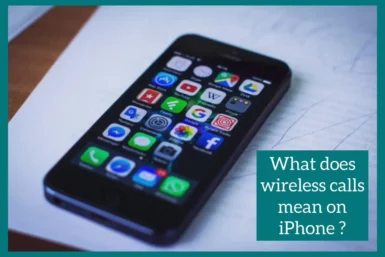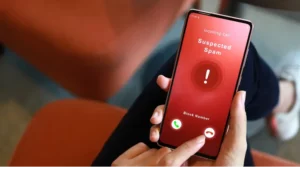Have you ever wondered what “Wireless Caller” signify when it appears on your iPhone when you receive an incoming call?
This article will explain everything you need to know about wireless callers. We will explain what it means, how it differs from regular calls, and how to take safety precautions while attending an unknown call.
What Does “Wireless Caller” Mean on iPhone?
You might be curious and confused if your iPhone displays “Wireless Caller” on the screen during an incoming call.
Knowing how calls are identified through cellular networks, it is important to understand the significance of this label.
1. Identifying Calls from Cellular Networks
When a call comes in via a regular cellular network and the caller is not one of your contacts, “Wireless Caller” label will appear.
In this case, your iPhone is unable to display the caller’s name or phone number due to a lack of accurate data, resulting in the generic label.
2. Caller ID Information Is Not Present
The absence of caller ID details might occur for various reasons, such as the caller blocking their number or network limitations.
As a result, your device uses the standard “Wireless Caller label” to show that it cannot recognize the incoming call.
3. Network Settings and Carrier Compatibility
Sometimes wireless caller is displayed instead of the caller’s name or number due to carrier compatibility difficulties or incorrectly configured network settings.
4. Protection from Spam and Call Filtering
Wireless caller label can appear for unrecognized numbers on iPhones with call filtering or spam protection features, alerting users to a possibly unwanted or spam call.
Difference between “Wireless Caller” and Other Call Displays
The ‘wireless caller’ differs from other regular calls in the different ways as mentioned below:
1. Caller ID Names
A “Wireless Caller” call display differs from a standard call display in that it displays the caller’s name if the contact is saved in your phonebook.
When a call comes in from someone already in your contacts, your iPhone will show their name instead of wireless caller.
2. Contact Photos
The “Wireless Caller” label lacks customization, whereas a saved contact’s call displays their name and associated photo. The lack of a picture could indicate that the call comes from an unrecognized or unsaved number.
3. Number Display
Incoming calls from companies or people with caller ID enabled often display their phone number instead of wireless caller, which does not.
Even if you haven’t added the caller to your contacts, you can still recognize them because of this.
4. Spam or Scam Calls
Modern smartphones frequently have call protection tools that label spam or scam calls. If a call is suspicious, “Spam” or “Scam Likely” may appear instead of “Wireless Caller.”
5. Call Categories
Some smartphones let users classify their contacts into categories like “Family,” “Work,” or “Friends.”
The caller’s name may be accompanied by one or more of these categories, adding context where “Wireless Caller” does not.
6. Create Unique Labels for Specific Contacts
Some advanced call management programs or services enable users to create unique labels for contacts, further personalizing incoming calls. This level of customization is not possible with “Wireless Caller.”
Is Wireless Caller Spam?
The term “Wireless Caller” itself is not indicative of spam. Some smartphones use this general term when a call comes in from a number not saved in your contacts list or when the caller has disabled caller ID.
While wireless caller does not always indicate spam, it can be a disguise used by telemarketers or scammers.
When deciding whether the call is spam, you should also consider the caller’s actions, context, and any ominous or unexpected requests they may make.
You can prevent potential spam or fraudulent calls by using call protection settings and using caution when speaking with unknown callers.
Should You Answer a Wireless Caller?
Answering a wireless call depends on different circumstances. Before answering a wireless caller, you should consider the following factors to ensure your safety and privacy:
1. Recognizing the Risks
There are risks associated with answering a cellular call, particularly if the number is unlisted.
Telemarketers and scammers may use this general identification to hide their true identities and conduct illegal operations.
2. Assessing the Context
Consider the circumstance and the call’s importance. You might respond if it’s a private or professional problem.
It’s best to use caution if you’re unsure of the caller’s reasons for doing so.
3. Making Use of Call Protection
To help you spot potential spam or scam calls, enable call protection settings on your smartphone. It’s safer not to answer if the call has been marked as spam.
4. Making Safety a High Priority
You should make safety a high priority. It’s best not to answer if the call makes you uneasy or suspicious. Embrace your gut feeling and use caution.
5. Investigating the Number
Look up the phone number online to check whether it’s connected to any scams or other fraudulent practices. You can use this information to decide whether to answer the call or not.
6. Blocking Recurring Callers
If a particular wireless caller keeps calling you regularly and you think they are spam or unwanted, you could want to block their number to stop any further annoyances.
Conclusion
In conclusion, knowing what “Wireless Caller” means on an iPhone clarifies how calls made via cellular networks are identified.
Even though the label itself does not indicate spam, it is important to use caution while answering calls from blocked or unknown numbers. Potential risks associated with such calls can be minimized by prioritizing safety and call protection measures.


